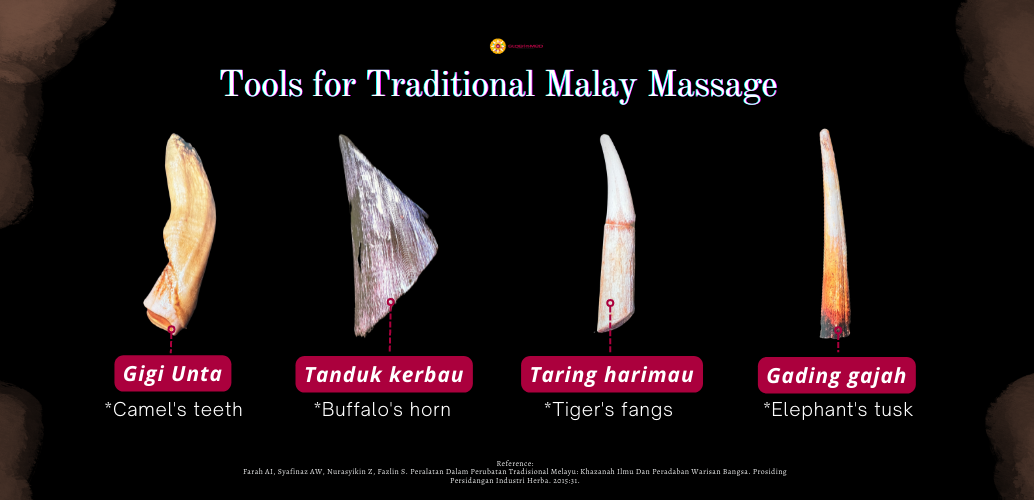Introduction
Urut Melayu, commonly known as Malay massage, is a therapeutic method that involves a combination of kneading, stroking, and pressing actions carried out with the hands, accompanied by applying herbal oils to enhance the massage experience. Throughout the massage, the practitioner utilizes their thumbs, palms, elbows, and/or feet to apply consistent and steady mechanical pressure. Some practitioners may also use massage tools such as wooden sticks, combs, horns, or other aids to aid in the massage process. Urut Melayu emphasizes on the manipulation of muscles and/or surrounding soft tissues, aiming to stimulate various systems within the body, including the lymphatic, circulatory, and nervous systems [6]. Malay massage sometimes combines the recitation of prayers as part of the practice and ends with stretch movements.
Malay massage is also used in
- Postnatal massage: This massage is intended and performed on mothers during their confinement period and typically involves additional treatments like herbal baths, bertungku (body heat compression), berbengkung (body wrapping) and Param Pilis Tapel (application of herbal paste on the mother’s body).
- Urut patah: Also known as bone-setting massage, this massage technique is specific on treating broken bones through patting, rubbing, and stretching along the affected bone, accompanied by prayer recitations. Some practitioners symbolically apply this technique to objects like chicken bones, skewers, or canes to represent broken bones. Some may also use healing water (performed by prayer recitations).
- Therapeutic massage: This type of massage targets specific areas of the body that are in pain or illness to provide relief and promote healing [1].
- Reproductive vitality enhancement massage: This massage concentrates on particular body parts to improve the functionality of the reproductive system, aiming to enhance overall reproductive health.
Practice and Statistics
In Malaysia, Traditional Malay Massage is officially one of the modalities in Traditional and Complementary Medicine (T&CM) conducted by selected hospitals under the Ministry of Health since 2007 [2]. However, the vast majority of the Urut Melayu is provided at the practitioner’s house [6].
According to a national survey (National Health and Morbidity Survey (NHMS)), 2015 made by the Malaysian government, the most popular T&CM practice modality among the Malaysian population was Malay massage (41.92%). Urut Melayu users go for a massage to maintain wellness, 136 (17.19%) for treatment and 152 (19.22%) for a combination of both treatment and wellness [6].
Techniques
Numerous techniques could be used to perform Urut Melayu. The most famous technique is by using the practitioner’s own hand in applying sustained mechanical pressure at certain body points. During Urut Melayu treatment, various areas of the practitioner’s hand such as the thumbs, fingers, palms, and knuckles are used. Sometimes, forearms, elbows, and very rarely their knees and heels to massage the users. [3] The most common techniques practised by Malay massage practitioners are fan stroking, thumb stroking, kneading and stationary pressure [5] (Refer Figure1).

Various massage strokes such as kneading, rubbing, light and deep stroking [3] will be applied at different massage points, depending on the user’s condition. The massage is also facilitated by spreading minyak urut (a herbal oil) on the user’s body before applying any pressure. The strokes and techniques usually take a lot of the practitioner’s energy resulting in only limited patients per day to being treated. There are also practitioners that use aiding massage tools to achieve wanted results from this tradition of Urut Melayu.

Some of the aiding tools used are gading gajah, taring harimau, gigi unta and tanduk kerbau [4] (Refer figure 2 above). These tools are used differently, depending on the practitioners. These tools also need special care to maintain their form.
References
[1]Ernst E. The safety of massage therapy. Rheumatology. 2003 Sep 1;42(9):1101-6.
[2] Anuar HM, Fadzil F, Sallehuddin SM, Ahmad N, Ghani NA. A qualitative study on urut Melayu: The traditional Malay massage. The Journal of Alternative and Complementary Medicine. 2010 Nov 1;16(11):1201-5.
[3] Othman, C. N., Farooqui, M., Lamina, R. A. C., & Din, N. (2012). Malay traditional massage therapy (MTMT) seeking behaviours among Malays for their chronic diseases-case study. Procedia-Social and Behavioral Sciences, 50, 591-601.
[4] Farah AI, Syafinaz AW, Nurasyikin Z, Fazlin S. PERALATAN DALAM PERUBATAN TRADISIONAL MELAYU: KHAZANAH ILMU DAN PERADABAN WARISAN BANGSA. PROSIDING PERSIDANGAN INDUSTRI HERBA. 2015:31.
[5] Traditional and Complementary Medicine Practice Guideline on Malay Massage . 3rd ed. Kuala Lumpur, Selangor: Traditional and Complementary Medicine; 2018.
[6] National Health Morbidity Survey 2015: Traditional & Complementary Medicine Edition [Internet]. Kuala Lumpur (MY): Institute of Public Health; 2015 [cited on 5 July 2023]. Available from: https://iku.gov.my/images/IKU/Document/REPORT/NHMS2015-VolumeIV.pdf


